[1] In 531 A.D.
[2] Monk of Silo, sec. 14, who follows Sebastian of Salamanca; Robertson, iii. 6. We learn from the “Chron. Sil,” sec. 27, that Fruela (757-768) forbade the marriage of clergy. But these accounts of Witiza’s reign are all open to suspicion.
[3] Robertson, “Hist. of Christian Church,” vol. iii. p. 183.
The sudden surrender of their Arianism by the Gothic king and nobles is a noticeable phenomenon. All the barbarian races that invaded Spain at the beginning of the fifth century were inoculated with the Arian heresy. Of these the Vandals carried their Arianism, which proved to be of a very persecuting type, into Africa. The Suevi, into which nation the Alani, under the pressure of a common enemy, had soon been absorbed, gave up their Arianism for the orthodox faith about 560. The Visigoths, however, remained Arians until a somewhat later period—until 589 namely, when Recared I., the son of Leovigild, held a national council and solemnly abjured the creed of his forefathers, his example being followed by many of his nobles and bishops.
The Visigoths, while they remained Arian, were on the whole remarkably tolerant[1] towards both Jews and Catholics, though we have instances to the contrary in the cases of Euric and Leovigild, who are said to have persecuted the orthodox party. The latter king, indeed, who was naturally of a mild and forgiving temper, was forced into harsh measures by the unfilial and traitorous conduct of his son Ermenegild. If the latter had been content to avow his conversion to orthodoxy without entering into a treasonable rebellion in concert with the Suevi and Imperialists against his too indulgent father, there is every reason to think that Leovigild would have taken no measures against him. Even after a second rebellion the king offered to spare his son’s life—which was forfeit to the State—on condition that he renounced his newly-adopted creed, and returned to the Arian fold. His reason—a very intelligible one—no doubt was that he might put an end to the risk of a third rebellion by separating his son effectually from the intriguing party of Catholics. To call Ermenegild a martyr because he was put to death under such circumstances is surely an abuse of words.
[1] Lecky, “Rise of
Rationalism,” vol. i. p. 14, note, says
that the Arian Goths were
intolerant; but there seem to be
insufficient grounds for the
assertion.




